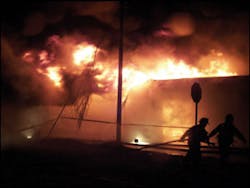Kokomo Fire Levels Multi-Use Structure
KOKOMO FIRE DEPARTMENT
Chief: David Duncan
Personnel: 120 career firefighters
Apparatus: Six engines, one reserve engine, one aerial, one quint, two squads, one hazmat van, one hazmat trailer, two boats, one service van, one BLS ambulance
Population: 50,000
Area: 28 square miles
On Nov. 26, 2004, fire destroyed a 71,700-square-foot multi-use building in downtown Kokomo, IN. The structure was built in 1908 by the Continental Steel Co. as a fence factory. It was constructed with brick exterior walls, heavy timber roof trusses and asphalt roofing. During the 1930s, it was used as a manufacturing facility for Globe American stoves; from 1941 through 1945, it was a defense plant making ammunition casings. In 1973, it was purchased by Star Building Supply and used for storage. At the time of the fire, the building was subdivided into seven businesses. The Blast Factory Paint Ball Arena occupied an office and a 24,565-square-foot arena; Star Building Supply storage; Newlons Metals warehouse; Satco Trailers; Cox Limo Service; and one unoccupied area. There were no fire protection or detection systems in the building. The weather was 42 degrees with light rain at the time of the fire. Winds were out of the south at 15 mph with gusts to 20 mph.
The Kokomo Fire Department was dispatched to a reported structure fire at 100 East North St. at 6:40 P.M. Engine 1, a 75-foot quint; Engine 3; Squad 1, a manpower unit; Ladder 6, a 102-foot aerial platform; and Ambulance 1, a basic life support (BLS) unit, responded with 14 firefighters under the command of Battalion Chief Gary Stevens. All occupants of the building had evacuated prior to the arrival of the fire department.
Stevens, the first-arriving officer, reported heavy smoke coming from the portion of the building along North Street occupied by Satco Trailers. Engine 1 laid a supply line to the east side of the building and Engine 3 dropped two 1¾-inch attack lines and a three-inch exposure-protection line on the west side and proceeded to reverse lay two three-inch supply lines to a hydrant on North Street in front of the building. This engine hooked on to the hydrant with five-inch soft suction. Ladder 6 laid a supply line from the corner of Tate and Main streets to the west side of the building. The ladder pipe was put into operation in an effort to keep the fire from spreading.
Stevens requested a second alarm at 6:45. Engine 2, Engine 4 and Squad 4 responded with a total of three firefighters. Engine 2 was positioned at the corner of North and Market streets and its crew was designated as the rapid intervention team (RIT). Engine 4 and Squad 4 were staged on North Street. The crew from Squad 4 was assigned to operate a portable monitor on the south side of the structure and the crew from Engine 4 was assigned to the north side with another portable monitor.
Interior crews reported debris falling from above them after being in the building for only five minutes. Stevens ordered interior crews out of the structure at 7 o’clock and defensive tactics were initiated. Engine 1 placed its aerial master stream into operation on the east side of the building.
At 7:30, Fire Chief Dave Duncan requested a third alarm, bringing Engine 5 and Engine 6 with six firefighters to the scene. Engine 6 reverse-laid two supply lines from Ladder 6 to a hydrant Main and Broadway. Engine 5 connected to the in-line relay valve supplying Ladder 6, giving it an output of 1,400 gpm from its ladder pipe.
The Howard County Emergency Management Agency (EMA) was requested to assist at 7:45 P.M. The agency responded with a grass fire truck, an air service truck and a 2,000-gallon tanker. The grass fire unit was assigned to extinguish spot fires along nearby railroad tracks caused by flying embers. The air supply truck was used at the scene to refill self-contained breathing apparatus (SCBA) cylinders. The tanker was placed on standby at the scene. EMA personnel manned portable monitors on the south side of the building.
At 10 o’clock, Duncan requested the recall of 27 off-duty firefighters to cover empty fire stations and to supply more manpower at the scene. Deputy Chief Pat Donoghue served as the resource officer, coordinating the deployment of the additional crews, as well as the response of the EMA and the Red Cross. Engine 8 responded to the scene with four off-duty firefighters and reverse laid two three-inch supply lines from the north side of the building to a hydrant at the corner of Tate and Market streets. These two lines were equipped with master stream nozzles and used to set up a water curtain to keep the fire from jumping Tate Street into the next block, where a car wash and an auto-detailing center were located. A portable monitor supplied by two three-inch lines from Engine 5 was positioned at the northwest corner of the building to assist with the water curtain operation.
Stevens declared the fire under control at 1:30 A.M. on Nov. 27. Mutual aid crews were released at 4 A.M. and Kokomo units left the scene at 4:09. There were no injuries to firefighters or civilians.
The cause of the fire remains under investigation by the Kokomo Fire Department Investigative Unit headed by Battalion Chief Pat O’Neil. Damage was estimated at $750,000 to the building and $300,000 to the contents.
Jay K. Bradish/IFPA, Firehouse® news editor, is a former captain in the Bradford Township, PA, Fire Department. He has been a volunteer firefighter and fire photographer for more than 25 years.